Charles Kingsford Smith
Sir Charles Edward Kingsford Smith, MC, AFC (9 February 1897 – 8 November 1935), often called by his nickname Smithy, was an early Australian aviator.[3]
Charles Kingsford Smith | |
|---|---|
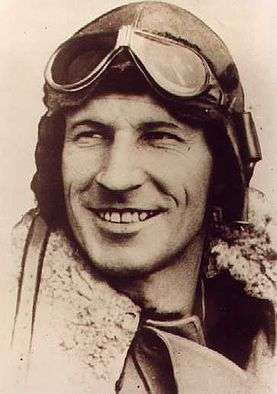 Kingsford Smith in his flying gear | |
| Born | 9 February 1897 Brisbane, Queensland, Australia |
| Died | 8 November 1935 (aged 38) |
| Cause of death | Crashed in the sea off Burma |
| Nationality | British subject[1][2] Australian |
| Known for | First non-stop crossing of the Australian mainland Trans-Pacific flight England to Australia air race |
| Awards | Knight Bachelor Military Cross Air Force Cross Segrave Trophy |
| Aviation career | |
| Full name | Charles Edward Kingsford Smith |
| Air force | Australian Flying Corps Royal Flying Corps Royal Air Force |
| Battles | World War I
|
| Rank | Captain (substantive) Air Commodore (honorary) |
In 1928, he made the first transpacific flight from the United States to Australia. He also made the first non-stop crossing of the Australian mainland, the first flights between Australia and New Zealand, and the first eastward Pacific crossing from Australia to the United States; and, also, made a flight from Australia to London, setting a new record of 10.5 days.
Early and personal life
Charles Edward Kingsford Smith was born on 9 February 1897 at Riverview Terrace, Hamilton in Brisbane, Queensland, Australia, the son of William Charles Smith and his wife Catherine Mary (née Kingsford, daughter of Richard Ash Kingsford, a Member of the Queensland Legislative Assembly and mayor in both Brisbane and Cairns municipal councils). His birth was officially registered and announced in the newspapers under the surname Smith, which his family used at that time.[4][5] The earliest use of the surname Kingsford Smith appears to be by his older brother Richard Harold Kingsford Smith, who used the name at least informally from 1901, although he married in New South Wales under the surname Smith in 1903.[6][7]
In 1903, his parents moved to Canada where they adopted the surname Kingsford Smith. They returned to Sydney in 1907.[8]
Kingsford Smith first attended school in Vancouver, Canada. From 1909 to 1911, he was enrolled at St Andrew's Cathedral School, Sydney, where he was a chorister in the school's cathedral choir,[9]:39–40, 48 and then at Sydney Technical High School, before becoming an engineering apprentice with the Colonial Sugar Refining Company at 16.[8]
Kingsford Smith married Thelma Eileen Hope Corboy in 1923.[8] They divorced in 1929. He married Mary Powell in December 1930.[8]
Shortly after his second marriage he joined the New Guard,[8] a radical monarchist, anti-communist, and allegedly fascist-inspired organisation.[10]
World War I and early flying experience
In 1915, he enlisted for duty in the 1st AIF (Australian Army) and served at Gallipoli. Initially, he performed duty as a motorcycle dispatch rider, before transferring to the Royal Flying Corps, earning his pilot's wings in 1917.[8]
In August 1917, while serving with No. 23 Squadron, Kingsford Smith was shot down and received injuries[11] which required amputation of two toes.[12] He was awarded the Military Cross for his gallantry in battle.[8] As his recovery was predicted to be lengthy, Kingsford Smith was permitted to take leave in Australia where he visited his parents. Returning to England, Kingsford Smith was assigned to instructor duties and promoted to Captain.
On 1 April 1918, along with other members of the Royal Flying Corps, Kingsford Smith was transferred to the newly established Royal Air Force. On being demobilised in England, in early 1919, he joined Tasmanian Cyril Maddocks, to form Kingsford Smith, Maddocks Aeros Ltd, flying a joy-riding service mainly in the North of England, during the summer of 1919, initially using surplus DH.6 trainers, then surplus B.E.2s.[13] Later Kingsford Smith worked as a barnstormer in the United States before returning to Australia in 1921.[14] He did the same in Australia and also flew airmail services, and began to plan his record-breaking flight across the Pacific.[15]
Applying for a commercial pilot's licence on 2 June 1921 (in which he gave his name as 'Charles Edward Kingsford-Smith'),[16] he became one of Australia's first airline pilots when he was chosen by Norman Brearley to fly for the newly formed West Australian Airways.[8]
A young Kingsford Smith piloted a Western Australian Airways Bristol Type 28 Coupe Tourers plane (G-AUDF) that made bi-weekly mail drops to the astronomers during the 1922 Solar Eclipse expedition at Wallal, Western Australia.[17]
 Charles Kingsford-Smith at Wallal
Charles Kingsford-Smith at Wallal
During the First World War, Ken Richards had been the observer in Kingsford Smith's plane in France. Later Richards moved to Cowra, New South Wales. Kingsford Smith owned an old Avro plane and in 1922 flew to Cowra to see his old comrade. Kingsford Smith and Richards flew under the Cowra traffic bridge. They also attempted to fly under the nearby railway bridge, but Richards fortunately noticed the telephone lines and pulled the aircraft away only seconds from impact.[18]
1928 Trans-Pacific flight


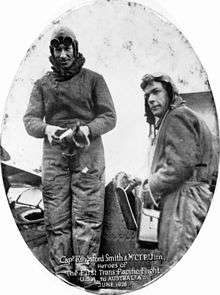
In 1928, Kingsford Smith and Charles Ulm arrived in the United States and began to search for an aircraft. Famed Australian polar explorer Sir Hubert Wilkins sold them a Fokker F.VII/3m monoplane, which they named the Southern Cross.[19]
At 8:54 a.m. on 31 May 1928,[19] Kingsford Smith and his 4-man crew left Oakland, California, to attempt the first trans-Pacific flight to Australia. The flight was in three stages. The first, from Oakland to Wheeler Army Airfield, Hawaii,[20] was 3,870 kilometres (2,400 mi), taking an uneventful 27 hours 25 minutes (87.54 mph). They took off from Barking Sands on Mana, Kauai, since the runway at Wheeler was not long enough. They headed for Suva, Fiji, 5,077 kilometres (3,155 mi) away, taking 34 hours 30 minutes (91.45 mph). This was the most demanding portion of the journey, as they flew through a massive lightning storm near the equator.[21] The third leg was the shortest, 2,709 kilometres (1,683 mi) in 20 hours (84.15 mph), and crossed the Australian coastline near Ballina[22][23][24] before turning north to fly 170 kilometres (110 mi) to Brisbane, where they landed at 10.50 a.m. on 9 June. The total flight distance was approximately 11,566 kilometres (7,187 mi). Kingsford Smith was met by a huge crowd of 26,000 at Eagle Farm Airport, and was welcomed as a hero.[25][26][27][28] Australian aviator Charles Ulm was the relief pilot. The other crewmen were Americans, they were James Warner, the radio operator, and Captain Harry Lyon, the navigator and engineer.[29]
The National Film and Sound Archive of Australia has a film biography of Kingsford Smith, called An Airman Remembers,[30] and recordings of Kingsford Smith and Ulm talking about the journey.[31]
A stamp sheet and stamps, featuring the Australian aviators Kingsford Smith and Ulm, were released by Australia Post in 1978, commemorating the 50th anniversary of the flight.[32]
A young New Zealander named Jean Batten attended a dinner in Australia featuring Kingsford Smith after the trans-Pacific flight and told him "I'm going to learn to fly." She later convinced him to take her for a flight in the Southern Cross and went on to become a record-setting aviator, following his example instead of his advice ("Don't attempt to break men's records – and don't fly at night", he told her in 1928 and remembered wryly later).[33]
1928 Trans-Tasman flight
After making the first non-stop flight across Australia from Point Cook near Melbourne to Perth in Western Australia in August 1928, Kingsford Smith and Ulm registered themselves as Australian National Airways (see below). They then decided to attempt the Tasman Sea crossing to New Zealand not only because it had not yet been done, but also in the hope the Australian Government would grant Australian National Airways a subsidised contract to carry scheduled mail regularly.[34] The Tasman had remained unflown after the failure of the first attempt in January 1928, when New Zealanders John Moncrieff and George Hood had vanished without trace.[35]
Kingsford Smith's flight was planned for take off from Richmond, near Sydney, on Sunday 2 September 1928, with a scheduled landing around 9:00 a.m. on 3 September at Wigram Aerodrome, near Christchurch, the principal city in the South Island of New Zealand. This plan drew a storm of protest from New Zealand churchmen about the "sanctity of the Sabbath being set at naught."[36]

The mayor of Christchurch supported the churchmen and cabled a protest to Kingsford Smith. As it happened, unfavourable weather developed over the Tasman and the flight was deferred, so it is not known whether or how Kingsford Smith would have heeded the cable.[34]
Accompanied by Ulm, navigator Harold Arthur Litchfield, and radio operator Thomas H. McWilliams, a New Zealander made available by the New Zealand Government, Kingsford Smith left Richmond in the evening of 10 September, planning to fly overnight to a daylight landing after a flight of about 14 hours. The 2,600 kilometres (1,600 mi) planned route was only just over half the distance between Hawaii and Fiji. After a stormy flight, at times through icing conditions, the Southern Cross made landfall in much improved weather near Cook Strait, the passage between New Zealand's two main islands. At an estimated 241 kilometres (150 mi) out from New Zealand, the crew dropped a wreath in memory of the two New Zealanders who had disappeared during their attempt to cross the Tasman earlier that year.[37]
There was a tremendous welcome in Christchurch, where the Southern Cross landed at 0922 after a flight of 14 hours and 25 minutes. About 30,000 people made their way to Wigram, including many students from state schools, who were given the day off, and public servants, who were granted leave until 11 a.m.[37] The event was also broadcast live on radio.[38]
While the New Zealand Air Force overhauled the Southern Cross free of charge Kingsford Smith and Ulm were taken on a triumphant tour of New Zealand, flying in Bristol Fighters.[34] The return to Sydney was made from Blenheim, a small city at the north of the South Island. Hampered by fog, severe weather and a minor navigational error, the flight to Richmond took over 23 hours; on touchdown the aircraft had enough fuel for only another 10 minutes flying.[34]
_at_Invercargill%2C_New_Zealand_(c.1930).jpg)
"Coffee Royal" incident
On 31 March 1929, en route from Sydney to England, the Southern Cross with Kingsford Smith at the helm made an emergency landing on a mudflat near the mouth of the Glenelg River, in the Kimberley region of northern Western Australia. The Southern Cross was found and rescued after a fortnight's searching, with George Innes Beard, Albert Barunga and Wally from the Kunmunya Mission the first overland party to reach the downed aircraft.[39]
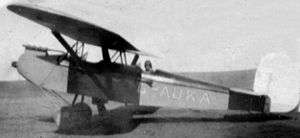
While on their way to help with the search two friends of Kingsford Smith crash landed in the Tanami Desert in Central Australia and died of thirst and exposure on 12 April 1929. The pair, Keith Vincent Anderson and Henry Smith "Bobby" Hitchcock, had been flying a Westland Widgeon plane named Kookaburra. Many sections of the media and public felt that the forced landing of the Southern Cross, which was dubbed the "Coffee Royal" incident after the brew of coffee and brandy which the crew had drunk while awaiting rescue, had been a publicity stunt and that Kingsford Smith was responsible for the two deaths.[40][41]
An official inquiry was convened into the incident, fuelled by the media speculation. One of the criticisms levelled at Kingsford Smith was that he could have been spotted and rescued much more quickly had he set a fire with engine oil. The foundation for the attack was not tested by the inquiry at the time but Dick Smith (no relation) rediscovered the landing site in 1981 and carried out an experiment burning brush with and without engine oil and found that the latter actually created a more visible effect as viewed from the air against the dark mud and surface terrain; Kingsford Smith had been right.[40]
Despite Kingsford Smith being exonerated by the inquiry, his reputation within Australia never fully recovered during his lifetime.[42]
The bodies of Anderson and Hitchcock were later recovered from the Tanami Desert. Hitchcock's body was returned to Perth for burial at Karrakatta Cemetery, while Anderson's body was returned to Sydney. Over 6000 mourners attended Keith Anderson's funeral. It was an elaborate affair befitting a national hero. Anderson was buried at Rawson Park, Mosman, on 6 July 1929. A grand memorial was later erected at the gravesite in his honour.[43]
Australian National Airways
In partnership with Ulm, Kingsford Smith established Australian National Airways in 1929. The passenger, mail and freight service commenced operations flying between Sydney, Brisbane and Melbourne, in January 1930, with five aircraft but closed after crashes in March and November the next year.[44]
Later flights
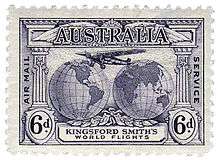
After collecting his 'old bus', Southern Cross, from the Fokker aircraft company in the Netherlands where it had been overhauled, in June 1930 he achieved an east–west crossing of the Atlantic from Ireland to Newfoundland in 31½ hours, having taken off from Portmarnock Beach (The Velvet Strand), just north of Dublin. New York gave him a tumultuous welcome. The Southern Cross continued on to Oakland, California, completing a circumnavigation of the world, begun in 1928.[45] In 1930, he competed in an England to Australia air race, and, flying solo, won the event taking 13 days. He arrived in Sydney on 22 October 1930.[46]

In 1931, he purchased an Avro Avian he named the Southern Cross Minor, to attempt an Australia-to-England flight. He later sold the aircraft to Captain W.N. "Bill" Lancaster who vanished on 11 April 1933 over the Sahara Desert; Lancaster's remains were not found until 1962. The wreck of the Southern Cross Minor is now in the Queensland Museum.[47] In the early 1930s, Smith began developing the Southern Cross automobile as a side project.[48][49]
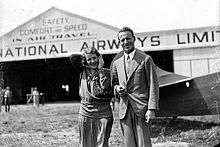
In 1933, Seven Mile Beach, New South Wales, was used by Kingsford Smith as the runway for the first commercial flight between Australia and New Zealand.[50]
In 1934, he purchased a Lockheed Altair, the Lady Southern Cross, with the intention of competing in the MacRobertson Air Race.[51] He was unable to make it to England in time for the start of the race, and so flew the Lady Southern Cross from Australia to the United States instead; the first eastward crossing of the Pacific Ocean by aircraft.[8]
Disappearance and death
Kingsford Smith and co-pilot John Thompson "Tommy" Pethybridge were flying the Lady Southern Cross overnight from Allahabad, India, to Singapore, as part of their attempt to break the England-Australia speed record held by C. W. A. Scott and Tom Campbell Black, when they disappeared over the Andaman Sea in the early hours of 8 November 1935. Aviator Jimmy Melrose claimed to have seen the Lady Southern Cross fighting a storm 150 miles (240 km) from shore and 200 feet (61 m) over the sea with fire coming from its exhaust.[52] Despite a search for 74 hours over the Bay of Bengal by test pilot Eric Stanley Greenwood, OBE, their bodies were never recovered.[51]
Eighteen months later, Burmese fishermen found an undercarriage leg and wheel, with its tyre still inflated, which had been washed ashore at Aye Island in the Gulf of Martaban, 3 km (2 mi) off the southeast coastline of Burma, some 137 km (85 mi) south of Mottama (formerly known as Martaban). Lockheed confirmed the undercarriage leg to be from the Lady Southern Cross.[53] Botanists who examined the weeds clinging to the undercarriage leg estimated that the aircraft lies not far from the island at a depth of approximately 15 fathoms (90 ft; 27 m).[54] The undercarriage leg is now on public display at the Powerhouse Museum in Sydney, Australia.[55]
In 2009, filmmaker and explorer Damien Lay stated he was certain he had found the Lady Southern Cross.[56] The location of the claimed find was widely misreported as "in the Bay of Bengal". However, the 2009 search, was in fact, at the same location where the landing gear had been found in 1937, at Aye Island in the Andaman Sea.[57]
Kingsford Smith was survived by his wife, Mary, Lady Kingsford Smith, and their three-year-old son Charles Jnr. Kingsford Smith's autobiography, My Flying Life, was published posthumously in 1937 and became a best-seller.[58]
Following The Joint Australian Myanmar Lady Southern Cross Search Expedition II (LSCSEII) in 2009, Lay conducted a total of ten further expeditions to Myanmar to recover wreckage from the site. In 2011, Lay claimed to have found the wreckage, but that claim has been widely disputed, and no evidence confirming the claim has been forthcoming. The location of the site, approximately 1.8 miles off the coast of Myanmar, has never been publicly released.[59]
Lay has worked closely with both the Kingsford Smith and Pethybridge families since 2005. The privately funded project was supported by the government and people of Myanmar.[60] As of December 2017, Lay was still searching for parts of the Lady Southern Cross.[61]
Honours and legacy
In 1930 Kingsford Smith was the inaugural recipient of the Segrave Trophy, awarded for "Outstanding Skill, Courage and Initiative on Land, Water [or] in the Air".[62]
Kingsford Smith was knighted in the 1932 King's Birthday Honours List as a Knight Bachelor.[63] He received the accolade on 3 June 1932 from His Excellency Sir Isaac Isaacs, the Governor-General of Australia, for services to aviation and later was appointed honorary Air Commodore of the Royal Australian Air Force.[64]
In 1986, Kingsford Smith was inducted into the International Air & Space Hall of Fame at the San Diego Air & Space Museum.[65]
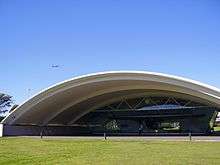
The major airport of Sydney, located in the suburb of Mascot, was named Kingsford Smith International Airport in his honour.[66] The federal electorate surrounding the airport is named the Division of Kingsford Smith, and includes the suburb of Kingsford.[67]
His most famous aircraft, the Southern Cross, is now preserved and displayed in a purpose-built memorial to Kingsford Smith near the International Terminal at Brisbane Airport.[68] Kingsford Smith sold the plane to the Australian Government in 1935 for £3000 so it could be put on permanent display for the public.[69][70] The plane was carefully stored for many years before the current memorial was built.
Kingsford Smith Drive in Brisbane passes through the suburb of his birth, Hamilton.[71] Another Kingsford Smith Drive, which is located in the Canberra district of Belconnen, intersects with Southern Cross Drive.[72]
Opened in 2009, Kingsford Smith School in the Canberra suburb of Holt was named after the famous aviator,[73] as was Sir Charles Kingsford-Smith Elementary School in Vancouver, British Columbia, Canada.[74]
He was pictured on the Australian $20 paper note (in circulation from 1966 until 1994, when the $20 polymer note was introduced to replace it), to honour his contribution to aviation and his accomplishments during his life.[75] He was also depicted on the Australian one-dollar coin of 1997, the centenary of his birth.[76]
Albert Park in Suva, where he landed on the trans-Pacific flight, now contains the Kingsford Smith Pavilion.[77][78]
A memorial stands at Seven Mile Beach in New South Wales commemorating the first commercial flight to New Zealand.[79]
Qantas named its sixth Airbus A380 (VH-OQF) after Kingsford Smith.[80]
KLM named one of its Boeing 747s (PH-BUM) after Kingsford Smith.[81]
A trans-Encke propeller moonlet, an inferred minor body, of Saturn is named after him.[82]
Australian aviation enthusiast Austin Byrne was part of the large crowd at Sydney's Mascot Aerodrome in June 1928 to welcome the Southern Cross and its crew following their successful trans-Pacific flight. Witnessing this event inspired Byrne to make a scale model of the Southern Cross to give to Kingsford Smith. After the aviator's disappearance, Byrne continued to expand and enhance his tribute with paintings, photographs, documents, and artworks he created, designed or commissioned. Between 1930 and his death in 1993, Byrne devoted his life to creating and touring his Southern Cross Memorial.[83]
In popular culture
- Kingsford Smith made a cameo appearance as himself in the feature film Splendid Fellows (1934)[84]
- A popular documentary was made about his life: The Old Bus (1934)[85]
- The 1946 Australian film Smithy was based on his life, with Ron Randell as Kingsford Smith and John Tate as Ulm[86]
- The 1985 Australian television mini-series A Thousand Skies, has John Walton as Kingsford Smith and Andrew Clarke as Ulm[87]
- Bill Bryson details Kingsford Smith's life in his book Down Under.[88]
- Australian author Peter FitzSimons's book Charles Kingsford Smith and Those Magnificent Men details an extensive exploration of Smithy's life and of aviation history (published by Harper Collins, Australia. 2009; (ISBN 978 0 7322 8819 8)
- The songs "Kingsford Smith, Aussie is Proud of You" and "Smithy" (1928) by Len Maurice[89]
- The songs "Smithy" and "Heroes of the Air" (1928) by Fred Moore[89]
- The songs "Smithy The King of the Air" and "The Southern Cross Monologue" by Clement Williams[89]
- Kingsford Smith is depicted on the cover art of the Icehouse album Code Blue which includes their song "Charlie's Sky"[90]
- The song "Charles Kingsford Smith" by Don McGlashan is on his Lucky Star album[91]
Notes
An aircraft similar to the Southern Cross, the Bird of Paradise, had made the first flight over (though not across) the Pacific, from California to Hawaii for the United States Army Air Corps, in 1927.[92]
References
- Citizenship in Australia Archived 9 August 2011 at the Wayback Machine — National Archives of Australia
- "Australian nationality law". Visaparaaustralia.com. Archived from the original on 25 April 2012.
- "Old newspaper articles. Kingsford Smith, Ulm, Southern Cross :: PIREP PILOT REPORTS". web.archive.org. 15 March 2012.
- "1897/C9077 birth of Smith, Charles Edward Kingsford". Queensland birth index. Queensland Government. Archived from the original on 12 March 2011. Retrieved 25 June 2017.
- "Family Notices". The Brisbane Courier. LIII (12, 196). Queensland, Australia. 13 February 1897. p. 4. Retrieved 25 June 2017 – via National Library of Australia.
- "Dramatic Art and Elocution Class". Morning Post (Cairns). 10 (47). Queensland, Australia. 15 January 1901. p. 2. Retrieved 25 June 2017 – via National Library of Australia.
- "3979/1903 Smith, Richard H K & Johnson, Elsie K St C". New South Wales Marriage Index. New South Wales Government. Retrieved 25 June 2017.
- Howard, Frederick. Australian Dictionary of Biography. Canberra: National Centre of Biography, Australian National University. Archived from the original on 4 November 2017. Retrieved 14 April 2019.
- Newth, Melville C (1980). Serving a Great Cause. Sydney: M C Newth. ISBN 0959455000.
- Sparrow, Jeff (22 July 2015). "If you oppose Reclaim Australia, remember fascism wasn't always a freakshow". The Guardian. Retrieved 8 June 2020.
- "Lieutenant Charles Edward Kingsford-Smith". Australian War Memorial. Archived from the original on 12 June 2018. Retrieved 9 June 2018.
- "Finding 'Smithy'" (PDF). National Museum of Australia. 2003. p. 6. Archived (PDF) from the original on 10 September 2015. Retrieved 9 June 2018.
- Aspin, Chris Dizzy Heights The Story of Lancashire's First Flying Men Helmshore Local History Society 1988 pp125-9 ISBN 0-906881-04-8
- "Fifty Australians". Awm.gov.au. 31 May 1928. Archived from the original on 4 December 2008.
- "Charles Kingsford Smith biography Ace Pilots". Acepilots.com. Archived from the original on 27 September 2011.
- "Application for pilot's licence – Charles Edward Kingsford-Smith". Archived from the original on 28 March 2009 – via National Archives of Australia.
- "Aviation". The West Australian. Perth, West Australia. 29 September 1922. p. 7 – via National Library of Australia.
- "Kingsford Smith flies under the Cowra traffic bridge". Cowra Tourism Corporation. February 2011. Archived from the original on 17 February 2011. Retrieved 4 February 2011.
- "7.30 report story about Charles Ulm". ABCnet.au. 31 May 1928. Archived from the original on 4 March 2016. Retrieved 21 September 2009.
- "Charles Kingsford-Smith – Hawaii Aviation". Hawaii.gov. Archived from the original on 2 October 2015.
- "The Great Pacific Flight". Flight. 20 (1016): 437. 14 June 1928. Archived from the original on 2 November 2013. Retrieved 31 August 2013.
- Kingsford-Smith, Charles; C. T. P. Ulm (1928). Story of "Southern Cross" Trans-Pacific Flight, 1928. Sydney: Penlington and Somerville.
- "Ballina Aero Club". Ballina Aero Club. 9 June 1928. Archived from the original on 9 April 2013.
- "Far North Coaster". Far North Coaster. 23 May 2008. Archived from the original on 3 November 2013. Retrieved 17 March 2012.
- Aviators - Charles Kingsford-Smith Archived 15 April 2014 at the Wayback Machine - (includes photo of the plaque commemorating the flight across the Pacific and the landing at Brisbane on 9 June 1928)
- "Brisbane - Eagle Farm - History of Eagle Farm - ourbrisbane.com". 24 January 2004. Archived from the original on 24 January 2004. Retrieved 20 March 2018.
- Photo of Southern Cross, and welcoming crowd, at Eagle Farm on 9 June 1928 (National Archives of Australia)
- "Magnificent Machines – Home-grown Legends (Sydney Morning Herald)". Sydney Morning Herald. Archived from the original on 20 October 2012.
- Lyon, Harry W. Captain; Kingsford-Smith, Charles Sir; Warner, James. (Interviewee); 2GB (Radio station : Sydney, N.S.W.) (1958), Reminiscences of flights in the "Southern Cross", retrieved 2 February 2017
- National Film and Sound Archive of Australia: 'An Airman Remembers' Archived 5 December 2011 at the Wayback Machine on australianscreen online Archived 2 March 2011 at the Wayback Machine
- National Film and Sound Archive of Australia: 'Our Heroes of the Air' Archived 31 January 2012 at the Wayback Machine
- Australia Post. Stamps and Philatelic Branch (1978), [Australia Post covers], Australia Post, Stamps and Philatelic Branch, retrieved 2 February 2017
- "NZEDGE Legends – Jean Batten, Pilot – Endurance". www.nzedge.com. Archived from the original on 24 September 2009. Retrieved 20 March 2018.
- Davis, P., 1977, Charles Kingsford Smith: Smithy, the World's Greatest Aviator, Summit Books, ISBN 0-7271-0144-7
- Anderson, Charles (14 July 2013). "Lost in the long white cloud". Stuff.co.nz. Archived from the original on 12 June 2018. Retrieved 8 June 2018.
- "Tasman Sea Flight". The Argus (Melbourne) (25, 604). Victoria, Australia. 3 September 1928. p. 13. Retrieved 8 June 2018 – via National Library of Australia.
- "Today in History | NZHistory, New Zealand history online". Nzhistory.net.nz. 11 September 1928. Archived from the original on 26 January 2016.
- "The first flight across the Tasman – National Library of New Zealand". Natlib.govt.nz. 11 September 1928. Archived from the original on 6 November 2012.
- McKenzie, Maisie (1969). The Road to Mowanjum. Angus & Robertson.
- Smith, Dick (1981). "Proving Smithy Right" (PDF). Panorama. Ansett Airlines. Archived (PDF) from the original on 23 March 2019. Retrieved 29 April 2019.
- FitzSimons, Peter (21 June 2009). "Knights of the air". Sydney Morning Herald. Retrieved 8 June 2020.
- Gwynn-Jones, Terry (1989). On a Wing and a Prayer. University of Queensland Press. ISBN 0-7022-2193-7.
- Gabrielle. "Keith Anderson WW1 Aviator". Keithandersonaviator.blogspot.com. Archived from the original on 7 February 2016.
- "Australian Dictionary of Biography". Archived from the original on 30 July 2008. Retrieved 13 September 2008.
- Gallagher, Desmond (1986). Shooting Suns and Things: Transatlantic Fliers at Portmarnock. Kingford Press. ISBN 0951156519.
- "Summary". The Sydney Morning Herald (28, 955). New South Wales, Australia. 23 October 1930. p. 1. Retrieved 9 June 2018 – via National Library of Australia.
- "The Pioneers – Chubbie Miller". Ctie.monash.edu.au. Archived from the original on 8 June 2011.
- "Australian-made Car". The Sydney Morning Herald. New South Wales, Australia. 15 June 1933. p. 6. Retrieved 8 June 2020 – via Trove.
- "At the Wheel Notes for Motorists". Morning Bulletin. Queensland, Australia. 29 March 1934. p. 5. Retrieved 8 June 2020 – via Trove.
- "Sir Charles Kingsford-Smith". monumentaustralia.org.au. Retrieved 8 June 2020.
- "A Great Pilot Passes". Flight: 525. 21 November 1935. Archived from the original on 22 April 2014. Retrieved 30 August 2013.
- "Kingsford-Smith missing in storm". The Bend Bulletin (132). 8 November 1935.
- "VH-USB "Lady Southern Cross" (Part 4)". Adastron.com. Archived from the original on 31 December 2015.
- By Aye Archived 17 September 2012 at the Wayback Machine TIME 6 June 1938
- "Aircraft undercarriage from the 'Lady Southern Cross', 1928 – 1938". Powerhousemuseum.com. Archived from the original on 5 January 2016.
- Justin, By (21 March 2009). "Sir Charles Kingsford Smith's final resting place found". News.com.au. Archived from the original on 23 March 2009.
- "Kingsford Smith? Not likely, says Dick Smith". Sydney Morning Herald. 22 March 2009. Archived from the original on 5 January 2016.
- Frederick Howard. Australian Dictionary of Biography – Online Edition. Previously published in Australian Dictionary of Biography. Volume 9, Melbourne University Press, 1983.
- Gibson, Joel (21 March 2009). "Kingsford Smith? Not likely, says Dick Smith". The Sydney Morning Herald. Archived from the original on 20 March 2018. Retrieved 20 March 2018.
- Pascuzzi, Carmine (2009). "Filmmaker Damien Lay goes in search of Sir Charles Kingsford Smith". Mediasearch. Archived from the original on 2 February 2017. Retrieved 2 February 2017.
- Moore, Tony (15 December 2017). "Spirit of adventure runs through generations of Charles Kingsford Smith's family". Sydney Morning Herald. Archived from the original on 12 June 2018. Retrieved 9 June 2018.
- "Past Winners". Royal Automobile Club. Archived from the original on 12 June 2018. Retrieved 9 June 2018.
- "1932 Birthday Honours". Flight. 24 (1224): 515. 10 June 1932. Archived from the original on 26 April 2014. Retrieved 31 August 2013.
- "Honours". The Sydney Morning Herald (29, 458). New South Wales, Australia. 3 June 1932. p. 9. Retrieved 9 June 2018 – via National Library of Australia.
- Sprekelmeyer, Linda, editor. These We Honor: The International Aerospace Hall of Fame. Donning Co. Publishers, 2006. ISBN 978-1-57864-397-4.
- "Kingsford-Smith". The Mercury. CXLV (20, 528). Tasmania, Australia. 14 August 1936. p. 11. Retrieved 8 June 2018 – via National Library of Australia.
- "Profile of the electoral division of Kingsford Smith (NSW)". Australian Electoral Commission. 10 February 2017. Archived from the original on 12 June 2018. Retrieved 8 June 2018.
- "Kingsford Smith Memorial". Brisbane Airport. Archived from the original on 12 June 2018. Retrieved 8 June 2018.
- "Southern Cross". The Sydney Morning Herald (30, 434). New South Wales, Australia. 19 July 1935. p. 11. Retrieved 8 June 2018 – via National Library of Australia.
- "Southern Cross". The Sydney Morning Herald (30, 570). New South Wales, Australia. 25 December 1935. p. 5. Retrieved 8 June 2018 – via National Library of Australia.
- "Hamilton Road". The Courier-mail. Queensland, Australia. 3 July 1953. p. 3. Retrieved 8 June 2018 – via National Library of Australia.
- "Roadwork tenders called". The Canberra Times. 44 (12, 557). Australian Capital Territory, Australia. 28 February 1970. p. 3. Retrieved 9 June 2018 – via National Library of Australia.
- "Kingsford Smith School - School Houses". ACT Education Directorate. Archived from the original on 12 June 2018. Retrieved 8 June 2018.
- "Sir Charles Kingsford-Smith Elementary School". Vancouver School Board. Archived from the original on 12 June 2018. Retrieved 8 June 2018.
- "Other Banknotes Paper Series". Reserve Bank of Australia. Archived from the original on 3 June 2018. Retrieved 8 June 2018.
- "One Dollar". Royal Australian Mint. Archived from the original on 12 June 2018. Retrieved 8 June 2018.
- Singh, Indra (21 May 2013). "SCC to renovate Albert Park". Fiji Broadcasting Corporation. Archived from the original on 12 June 2018. Retrieved 8 June 2018.
- "30 May 2003 - 75th Anniversary of Smithy's Landing at Albert Park". Australian High Commission Fiji. 30 May 2003. Archived from the original on 12 June 2018. Retrieved 8 June 2018.
- "Sir Charles Kingsford Smith Memorial and Lookout". New South Wales Government Destination NSW. Archived from the original on 2 October 2017. Retrieved 8 June 2018.
- Qantas’s sixth A380 arrives Archived 15 March 2011 at the Wayback Machine — Australian Aviation Magazine
- "PH-BUM - Boeing 747-206B(M)(SUD) - KLM Royal Dutch Airlines - MDVS - JetPhotos". JetPhotos. Archived from the original on 20 March 2018. Retrieved 15 April 2018.
- Tiscareno, Matthew S.; et al. (8 July 2010). "Physical Characteristics and Non-Keplerian Orbital Motion of "Propeller" moons embedded in Saturn's rings". The Astrophysical Journal Letters. 718 (2): 95. arXiv:1007.1008. Bibcode:2010ApJ...718L..92T. doi:10.1088/2041-8205/718/2/L92.
- corporateName=National Museum of Australia; address=Lawson Crescent, Acton Peninsula. "National Museum of Australia - Southern Cross memorial". www.nma.gov.au. Archived from the original on 28 August 2013.
- "Stage, Screen and Song". The Herald. Victoria, Australia. 19 November 1934. p. 15. Retrieved 8 June 2020 – via Trove.
- "New Films". The Sydney Morning Herald. New South Wales, Australia. 13 April 1935. p. 17. Retrieved 8 June 2020 – via Trove.
- ""Smithy" Premiere Has Ali Trimmings". The Sydney Morning Herald. New South Wales, Australia. 27 June 1946. p. 3. Retrieved 9 June 2020 – via Trove.
- "A thousand skies the story of Charles Kingsford Smith". Hobsobs Bay Libraries. Retrieved 9 June 2020.
- Bryson, Bill (2000). Down Under:Travels in a Sunburned Country. Doubleday. ISBN 0-552-99703-X.
- National Film and Sound Archive of Australia: Songs about Kingsford Smith featured in 'Our Heroes of the Air' Archived 31 January 2012 at the Wayback Machine
- "Code Blue Album". Icehouse. Retrieved 8 June 2020.
- "Album review: Don McGlashan, Lucky Stars". NZ Herald. 23 April 2015. Retrieved 8 June 2020.
- Murphy, William B. (1977). "Bird of Paradise" (PDF). 15th Air Base Wing Office of Information, USAF. Archived (PDF) from the original on 24 August 2011. Retrieved 2 August 2011.
Sources
- Howard, Frederick (1983). "Kingsford Smith, Sir Charles Edward (1897–1935)". Australian Dictionary of Biography. Melbourne University Press. ISSN 1833-7538. Retrieved 9 March 2009 – via National Centre of Biography, Australian National University.
- Serle, Percival (1949). "Smith, Charles Edward Kingsford". Dictionary of Australian Biography. Sydney: Angus and Robertson. Retrieved 16 October 2008.
External links
| Wikimedia Commons has media related to Charles Kingsford Smith. |
- The Pioneers – Charles Kingsford Smith
- Charles Kingsford Smith biography Ace Pilots
- Sir Charles Kingsford Smith Australian Heroes
- Charles Kingsford Smith about the Tasman flight
- Charles Kingsford Smith (includes photos of Sir Charles Kingsford Smith and his aeroplane, the Southern Cross)
- Sir Charles Kingsford Smith Sound Recordings and Newsreels
- Photographs from an album kept by Charles Ulm's wife, Mary, including many of Charles Kingsford Smith: National Museum of Australia
- Austin Byrne and the Kingsford Smith Southern Cross Memorial
- "Our Heroes of the Air" (audio recordings of Kingsford Smith and Ulm on the National Film and Sound Archive of Australia's website)
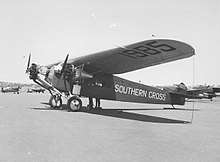
_By_Air.jpg)